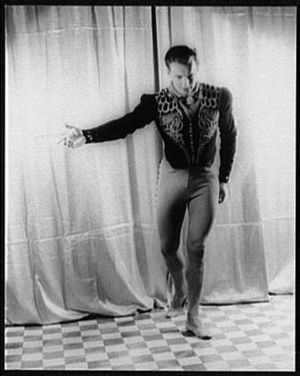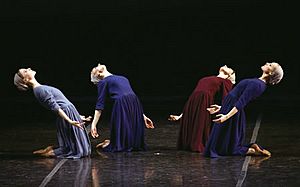Antony Tudor facts for kids
Quick facts for kids
Antony Tudor
|
|
|---|---|

Antony Tudor in Gala Performance, photographed by Carl Van Vechten, 1941
|
|
| Born |
William Cook
4 April 1908 London, England
|
| Died | 19 April 1987 (aged 79) New York City, U.S.
|
| Resting place | Ashes in Woodlawn Cemetery |
Antony Tudor (born William Cook; 4 April 1908 – 19 April 1987) was an English choreographer, teacher, and dancer. He helped create the London Ballet and later the Philadelphia Ballet Guild in Philadelphia, Pennsylvania, U.S.
Contents
Early Life and His Start in Dance
Tudor was born William Cook in East London and grew up in the Finsbury area. He found his love for dance by chance. He first saw professional ballet when he was a teenager. This was when he watched Sergei Diaghilev's famous Ballets Russes.
In 1928, he saw the dancer Serge Lifar perform in Apollon Musagète. Later, the Ballets Russes also introduced him to Anna Pavlova, another inspiring dancer. Tudor wanted to learn more about dance. He got advice from Cyril W. Beaumont, who owned a ballet book shop in London. Beaumont told him to study with Marie Rambert, a former dancer from the Diaghilev Ballet.
His Amazing Career in Ballet
Tudor started dancing professionally with Marie Rambert in 1928. The next year, he became a general assistant for her Ballet Club. He was a very talented choreographer even when he was young. At just 23, he created ballets like Cross Garter'd, Lysistrata, and The Planets.
He also created two of his most important works, Jardin aux lilas (Lilac Garden) and Dark Elegies, before he turned 30. He even danced the main roles in these ballets himself.
Founding Ballet Companies
In 1938, Tudor started the London Ballet with other dancers from Rambert's group. These dancers included his future partner Hugh Laing, Andrée Howard, Agnes de Mille, Peggy van Praagh, Maude Lloyd, and Walter Gore.
When World War II began in 1940, Tudor and his dancers were invited to New York. They joined a new company called Ballet Theater, which later became the famous American Ballet Theatre. Tudor worked closely with this company for the rest of his life.
Choreographer and Teacher
Tudor was a main choreographer for Ballet Theater for ten years. He brought back some of his older ballets and created new ones. His great works during this time included Pillar of Fire (1942), Romeo and Juliet, Dim Lustre, and Undertow.
After he stopped dancing in 1950, he became the head of the Metropolitan Opera Ballet School. He also taught often at the Juilliard School starting in 1950. He helped many dancers, including dancers of color. He also gave weekly classes at the Philadelphia Ballet Guild, which he started in the mid-1950s. One of his students, Carole King, later founded a dance college for Aboriginal and Torres Strait Islander students in Australia.
From 1963 to 1964, he was the artistic director for the Royal Swedish Ballet. He also created three ballets for the New York City Ballet.
Starting in 1973, Tudor continued teaching as a ballet professor at the University of California, Irvine. He rejoined American Ballet Theatre in 1974 as an associate artistic director. He created The Leaves Are Fading and Tiller in the Fields, which was his last major work, in 1978.
His Teaching Style
As a teacher, Tudor was known for paying close attention to small physical and mental details. He wanted to help dancers get rid of their personal habits to truly become the character in the ballet. He once said that breaking down a person's ego isn't hard, but you must be ready to help them rebuild themselves right away. He believed in pushing dancers beyond what they thought they could do.
Awards and Recognition
Antony Tudor received many awards for his work in dance. He was given a creative arts medal by Brandeis University. He also won awards from Dance Magazine and Capezio. New York City honored him with the Handel Medallion. He also received honors from the Kennedy Center and Dance/USA National Honors.
In 1988, Tudor was added to the Hall of Fame at the National Museum of Dance.
His Lasting Impact
Antony Tudor was a dedicated Zen Buddhist. He passed away on Easter Sunday in 1987, at the age of 79.
Many people agree that Tudor was one of the most original and important figures in modern dance. Along with George Balanchine, he is seen as someone who helped change ballet into a modern art form. His ballets often explored deep human feelings and were known for being elegant and noble, even though they used classical ballet steps. The famous dancer Mikhail Baryshnikov once said, "We do Tudor's ballets because we must. Tudor's work is our conscience."
About 30 of Tudor's dances have been written down using a special system called Labanotation by the Dance Notation Bureau. These notes include the history of the dances, who performed in them, and details needed to stage the ballets, like costumes, sets, and music.
The Antony Tudor Ballet Trust
The Antony Tudor Ballet Trust was created to make sure Tudor's ballets continue to be performed. In his will, Tudor chose Sally Brayley Bliss to be in charge of his ballets.
The trust includes special teachers called répétiteurs. These people know Tudor's ballets very well and help other dancers learn and perform them correctly.
Major Works
(*Ballets available for production)
- Adam and Eve (1932)
- Atalanta of the East (1933)
- Britannia Triumphans (1953)
- Cereus * (1971)
- A Choreographer Comments * (1960)
- Concerning Oracles (1966)
- Constanza's Lament (1932)
- Continuo * (1971)
- Cross Garter'd (1931)
- Dance Studies (less Orthodox) * (1961)
- Dark Elegies * (1937)
- The Day Before Spring (1945)
- The Dear Departed (1949)
- The Decent of Hebe (1935)
- Dim Lustre * (1943)
- The Divine Horsemen * (1969)
- Echoing of Trumpets * (1963)
- Elizabethan Dances (1953)
- Fandango * (1963)
- Exercise Piece * (1953)
- Gala Performance * (1938)
- Galant Assembly (1937)
- La Gloire (1952)
- Goya Pastoral (1940)
- Hail and Farewell (1959)
- Judgment of Paris * (1938)
- Knight Errant (1968)
- Lady of Camellias (1951)
- Leaves are Fading * (1975)
- The Legend of Dick Whittington (1934)
- La Leyenda de Jose (1958)
- Lilac Garden (Jardin Aux Lilas) * (1936)
- Little Improvisations * (1953)
- Lysistrata (1932)
- Les Mains Gauches * (1951)
- Mr. Roll's Quadrilles (1932)
- Nimbus (1950)
- Offenbach in the Underworld *(1954)
- Paramour (1934)
- Pas de Trois * (1956)
- Passamezzi (1962)
- Pavane pour une Infante Defunte (1933)
- Pillar of Fire * (1942)
- The Planets * (1934)
- The Tragedy of Romeo and Juliet * (1943)
- Ronde du Printemps (1951)
- Seven Intimate Dances (1938)
- Shadow of the Wind (1948)
- Shadowplay * (1967)
- Soiree Musicale * (1938)
- Suite of Airs (1937)
- Sunflowers * (1971)
- The Tiller in the Fields (1978)
- Time Table (1941)
- Trio con Brio * (1952)
- Undertow * (1945)
See Also
 In Spanish: Antony Tudor para niños
In Spanish: Antony Tudor para niños
- List of dancers


